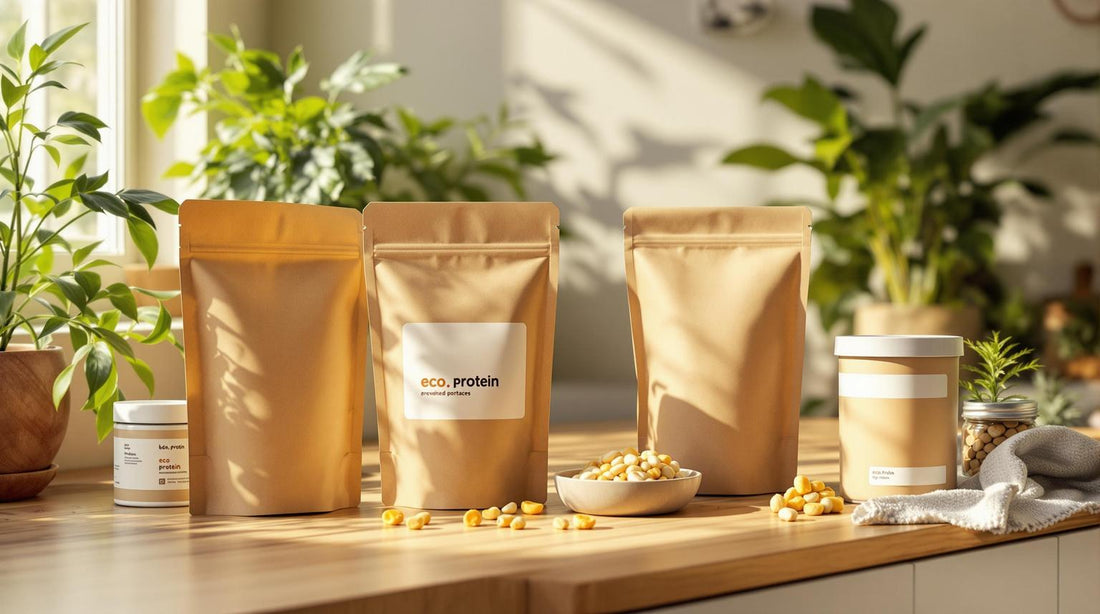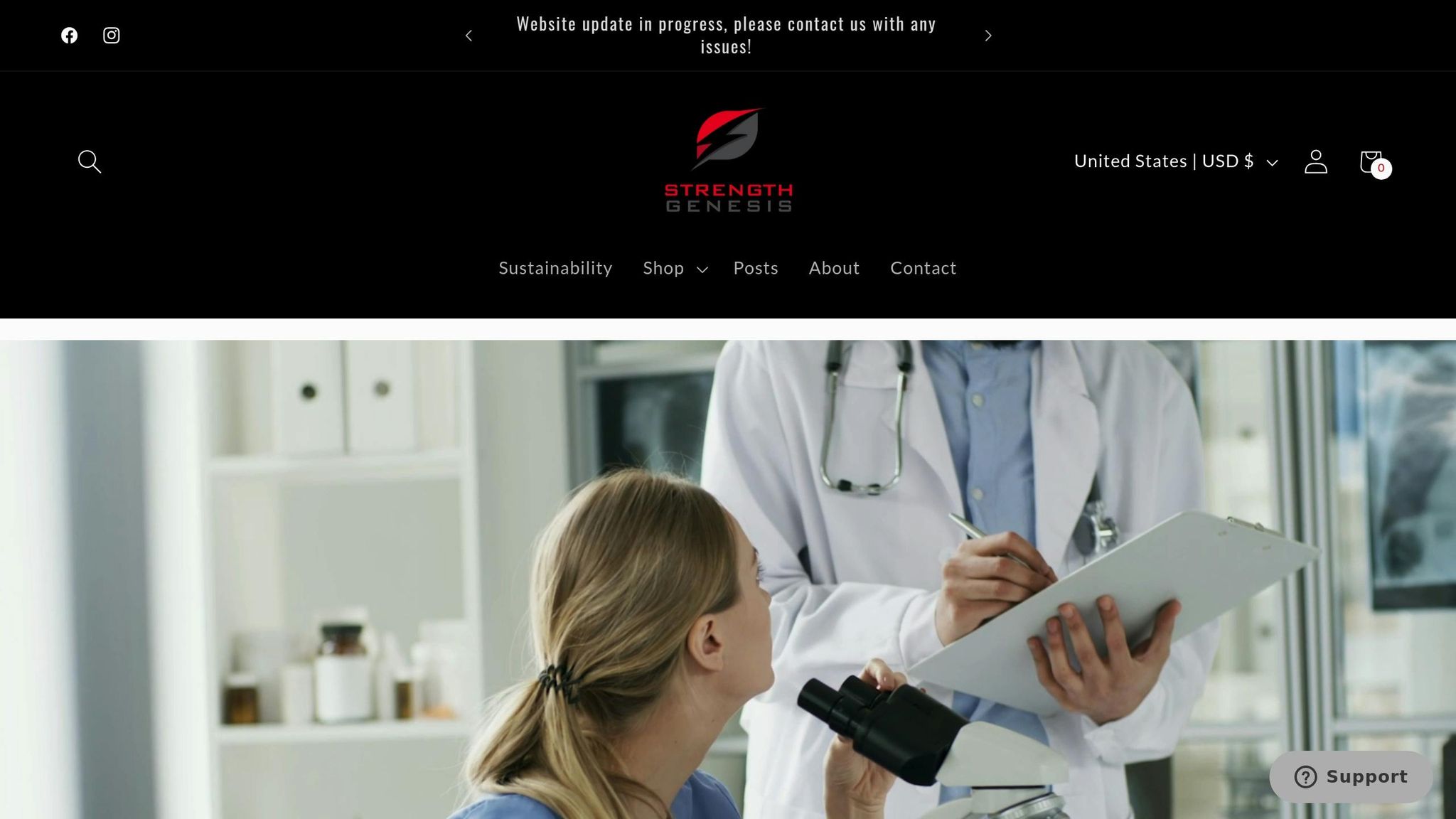
Eco-Friendly Protein Packaging: What to Look For
Want to make better choices for the planet while buying protein supplements? Here's what you need to know about eco-friendly packaging:
- Biodegradable Materials: Look for packaging made from soy, cornstarch, or plant-based plastics that break down naturally.
- Recyclable Options: Post-Consumer Recycled (PCR) materials and fully recyclable designs reduce waste.
- Less Packaging Waste: Choose lightweight, minimal designs that avoid unnecessary layers.
- Reusable Containers: Durable containers that can be used multiple times cut down on single-use waste.
- Safe Inks & Adhesives: Water-based, heavy-metal-free, and low-VOC inks and adhesives are better for the environment.
Quick Tips:
- Check Labels: Look for certifications like BPI, FSC, or How2Recycle for verified eco-claims.
- Consider Disposal: Opt for compostable or easily recyclable materials like glass or metal.
- Support Green Brands: Companies like Strength Genesis use glass and metal containers instead of plastic.
By making smarter packaging choices, you can protect the planet while staying healthy. Let’s dive into the details.
Protein Powder Packaging Solutions: Eco-Friendly & Durable ...
Types of Earth-Friendly Packaging Materials
Protein packaging is now shifting toward materials designed to protect both products and the planet. Here’s a breakdown of some key eco-friendly packaging options.
Biodegradable and Compostable Options
Biodegradable packaging, like protein-based plastics made from soy or cornstarch, decomposes naturally under the right conditions. However, the time it takes to break down can vary depending on the material.
"The sustainability, biodegradability, renewability, and appropriate mechanical and techno-functional properties of proteins from plant origin make them an emerging substitute to the conventional synthetic polymers currently used as food packaging." - Trends in Food Science and Technology
Recyclable Materials
Recyclable packaging plays a major role in cutting down long-term waste. Post-Consumer Recycled (PCR) materials are increasingly popular, with some companies now offering fully recyclable packaging that doesn’t compromise product quality.
To understand the importance of recyclability, consider these global packaging statistics:
| Global Packaging Statistics | Percentage |
|---|---|
| Plastic used in packaging | 42% |
| Plastic packaging recycled | 14% |
Plant-Based Materials
Plant-based packaging solutions are another way to reduce the environmental impact of protein packaging. Materials derived from corn or sugarcane provide reliable protection while being easier on the environment.
Plant protein-based packaging stands out for its:
- Strong gas barrier properties
- Lower production costs
- Ability to maintain product quality and safety
If current plastic consumption trends continue, the planet could see an additional 33 billion tons of plastic waste by 2050. Plant-based materials offer a way to protect products while minimizing harm to the environment.
What Makes Protein Packaging Earth-Friendly
Less Packaging Waste
Eco-friendly protein packaging focuses on using fewer materials while still providing adequate protection. This is achieved by:
- Designing containers with efficient shapes
- Removing unnecessary layers of packaging
- Using lightweight materials that are still sturdy
In addition to cutting down waste, well-designed packaging can often serve additional purposes.
Reusable Containers
Reusable packaging is built to be used multiple times, which helps lower waste and conserve resources.
"Reusable packaging describes a sustainable approach to product packaging that is designed particularly for multiple cycles of use... It focuses on durability, ease of access and cleaning and often comes equipped with sealing mechanisms and stackability." - Ben Kaplan
These containers offer several benefits:
| Benefit | Impact |
|---|---|
| Resource Conservation | Reduces the need for raw materials like timber and petroleum |
| Energy Savings | Uses less energy compared to manufacturing single-use packaging |
| Waste Reduction | Decreases the amount of packaging that ends up in landfills |
Every part of the packaging, from the container itself to the inks and adhesives used, plays a role in making it environmentally responsible.
Safe Inks and Adhesives
The choice of inks and adhesives also affects the environmental impact of protein packaging. These components should meet certain criteria, such as being water-based, free from heavy metals, low in volatile organic compounds (VOCs), and recyclable.
Look for certifications from organizations like the American Society for Testing and Materials (ASTM) to ensure that all parts of the packaging meet safety and sustainability standards.
sbb-itb-132bd3c
Measuring Environmental Effects
To understand the impact of protein packaging on the environment, it's essential to look at several factors that shape its ecological footprint. Here's a closer look at the metrics and considerations that define eco-conscious packaging.
Carbon Footprint
The carbon footprint of packaging materials is measured in carbon dioxide equivalents (CO2e), which represents the total greenhouse gas emissions across the material's lifecycle. As one source explains, "Carbon footprinting is much more useful as a way of helping companies identify 'hot-spots' where emissions are highest and where attention needs to be focused." For instance, polyethylene packaging produces between 2.2 and 6.6 pounds of CO2e per pound of material, depending on how and where it's made.
| Production Location | Impact Factors |
|---|---|
| Nuclear Energy Countries | Lower carbon footprint |
| Coal-Dependent Regions | Higher carbon footprint |
| Modern Facilities | Greater manufacturing efficiency |
These figures highlight how production choices can significantly influence the environmental impact of packaging.
Production Methods
The way packaging is manufactured plays a big role in its environmental footprint. For example, gusseted bag designs use materials more efficiently, cutting down on waste and reducing the emissions tied to transportation. Many manufacturers are also adopting circular economy principles to minimize waste and emissions throughout the production process.
The final piece of the puzzle is how packaging is disposed of after use.
Disposal Options
The end-of-life stage of protein packaging is critical in evaluating its overall environmental impact. Disposal methods vary depending on the material, but there are several eco-friendly options. For example, compostable materials like Green Cell Foam can be broken down at home, in municipal composting programs, or through industrial facilities.
| Disposal Method | Environmental Benefits | Timeline |
|---|---|---|
| Home Composting | Enriches soil, avoids methane | 6–12 months |
| Industrial Composting | Processes larger volumes | Varies by facility |
| Container Recycling | Promotes material reuse | Immediate |
These options show how thoughtful disposal practices can help reduce the environmental burden of packaging.
Green Packaging Labels and Certificates
Official Green Certificates
Eco-certifications help confirm that protein packaging meets environmental standards. Here are some key certifications to look for:
| Certification | Purpose | Indicators |
|---|---|---|
| Biodegradable Products Institute (BPI) | Confirms products meet biodegradability standards | BPI logo with certification number |
| Compost Certifications | Validates claims for home or industrial compostability | Labels like "OK Compost Home" or "OK Compost Industrial" |
| Forest Stewardship Council (FSC) | Ensures responsible forest management practices | FSC logo with chain of custody number |
| Recycled Content (RCS) | Verifies the percentage of recycled materials used | Certification number and percentage displayed |
These certifications undergo third-party verification to ensure they meet environmental guidelines. For example, the Forest Stewardship Council evaluates forest management practices, chain of custody, social policies, and ecosystem care.
Reading Recycling Labels
Recycling symbols on packaging can tell you a lot, but it’s important to know how to interpret them. In 2023, California’s SB-343 law restricted recycling symbols to materials that are genuinely recyclable.
- Material Type: Check the Resin Identification Code (RIC) on plastic packaging.
- Local Guidelines: Confirm the recyclability of materials based on your area’s recycling rules.
- Preparation Instructions: Look for any specific steps needed before recycling.
"The How2Recycle label provides consistent and transparent on-pack disposal information to consumers in the US and Canada." - How2Recycle
Checking Package Claims
To verify environmental claims on packaging, consider these steps:
- Scan QR Codes: Many packages now include QR codes that provide detailed certification information.
- Check Standards: Look for compliance with ISO 17065 or ISO 14021.
- Seek Clear Documentation: Claims should be specific and measurable, not vague or generic.
Environmental claims should always be "clear, truthful, accurate, and substantiated". Avoid relying on broad terms like "eco-friendly" unless there’s supporting evidence or certification. Third-party verification is the most reliable way to confirm these claims, but manufacturers are still responsible for ensuring their statements are accurate. By understanding these labels and claims, you can make informed, environmentally conscious choices.
Choosing Earth-Friendly Brands
A brand's packaging often reveals its commitment to reducing environmental impact through practical, eco-conscious choices.
Strength Genesis: A Leader in Eco-Friendly Packaging

Strength Genesis takes steps to lower its impact by removing styrofoam, mylar, and plastic from its containers, shipping boxes, and master cartons. Instead, it opts for materials like glass and metal that are better for the planet.
| Product Type | Packaging Material | Benefit to the Environment |
|---|---|---|
| Oils & Liquids | Glass bottles | Recyclable and avoids chemical contamination |
| Protein Products | Metal containers | Easy to recycle and keeps contents fresh |
| Shipping Materials | Plastic-free boxes | Cuts down on petroleum-based materials |
Here are a few standout products that highlight these packaging efforts:
- Australian Extra Virgin Macadamia Nut Oil: Comes in recyclable glass bottles that protect the product's quality.
- Pur Zealand 100% Grass-Fed Whey Protein: Packaged in metal containers that combine durability with sustainability.
- High Octane Organic MCT Oil: Delivered in reusable, recyclable glass bottles.
"Strength Genesis™ is committed to providing products and packaging that are both good for people and the planet." - Strength Genesis
Next Steps for Better Packaging Choices
Now that we've gone over eco-friendly packaging materials and their impact, here are some practical steps to help you make smarter packaging decisions for your protein supplements.
When choosing packaging, keep these tips in mind:
- Check disposal options: Pick packaging that's easy to recycle or compost. Materials like glass and metal are fully recyclable and great choices.
- Minimize material waste: Look for products with little to no excess packaging. Containers should match the size of their contents to cut down on wasted materials and lower shipping emissions.
- Confirm eco-friendly claims: Don’t get swayed by flashy marketing. Genuine eco-friendly packaging includes clear recycling instructions and certified symbols.
These steps can help you make better choices that align with sustainable practices.
"Sustainable packaging is not just a trend but a necessity in today's environmentally conscious world." - Primary Packaging Inc.
Beyond choosing better materials, consider supporting brands that prioritize a cleaner future. For instance, Strength Genesis stands out by using glass and metal packaging, setting an example for others to follow.
